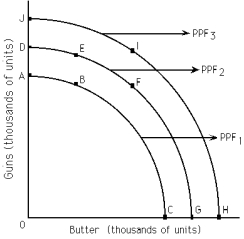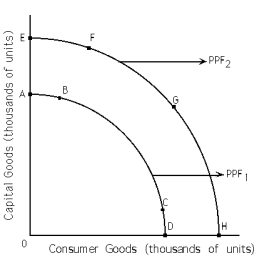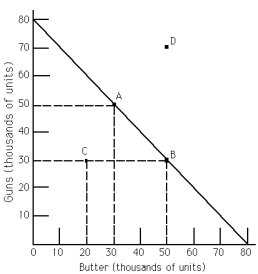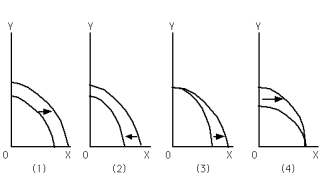A) straight line if increasing opportunity costs exist.
B) straight line if decreasing opportunity costs exist.
C) curve that is bowed inward if increasing opportunity costs exist.
D) straight line if constant opportunity costs exist.
F) A) and C)
Correct Answer

verified
Correct Answer
verified
Multiple Choice
Exhibit 2-2
 -Refer to Exhibit 2-2.If PPF? is the relevant production possibilities frontier,then point __________ is unattainable.
-Refer to Exhibit 2-2.If PPF? is the relevant production possibilities frontier,then point __________ is unattainable.
A) A
B) G
C) D
D) J
F) All of the above
Correct Answer

verified
Correct Answer
verified
Multiple Choice
With a constant opportunity cost between goods A and B,the PPF for goods A and B would
A) be a straight line.
B) be a bowed-outward line.
C) be a bowed-inward line.
D) not exist.
F) C) and D)
Correct Answer

verified
Correct Answer
verified
Multiple Choice
Exhibit 2-3
 -Refer to Exhibit 2-3.If PPF? is the relevant production possibilities frontier,PPF? may depict
-Refer to Exhibit 2-3.If PPF? is the relevant production possibilities frontier,PPF? may depict
A) economic growth.
B) an increase in resources.
C) an increase in technology.
D) both b and c
E) all of the above
G) D) and E)
Correct Answer

verified
Correct Answer
verified
Multiple Choice
Exhibit 2-9
 -Refer to Exhibit 2-9.For Alex,the opportunity cost of producing one unit of good A is ____________ unit(s) of good B.
-Refer to Exhibit 2-9.For Alex,the opportunity cost of producing one unit of good A is ____________ unit(s) of good B.
A) 3.00
B) 0.33
C) 0.75
D) 1.33
F) None of the above
Correct Answer

verified
Correct Answer
verified
Multiple Choice
Exhibit 2-9
 -Refer to Exhibit 2-9.Who has the comparative advantage in the production of good A?
-Refer to Exhibit 2-9.Who has the comparative advantage in the production of good A?
A) Alex
B) Adam
C) Both Alex and Adam
D) Neither Alex nor Adam
F) A) and D)
Correct Answer

verified
Correct Answer
verified
Multiple Choice
Which of the following statements is true?
A) The concept of opportunity costs cannot be illustrated within a PPF framework.
B) If scarcity did not exist, neither would a PPF.
C) All PPFs are downward-sloping straight lines.
D) There are more attainable points than unattainable points in every PPF diagram.
F) None of the above
Correct Answer

verified
Correct Answer
verified
Multiple Choice
Exhibit 2-1
 -Refer to Exhibit 2-1.The movement from point A to point B is a movement from
-Refer to Exhibit 2-1.The movement from point A to point B is a movement from
A) a productive efficient point to a productive inefficient point.
B) a point with more guns and less butter to a point with more butter and even more guns.
C) a productive efficient point to another productive efficient point.
D) a productive inefficient point to a productive efficient point.
F) None of the above
Correct Answer

verified
Correct Answer
verified
Multiple Choice
Exhibit 2-1
 -Refer to Exhibit 2-1.A movement from point B to point D
-Refer to Exhibit 2-1.A movement from point B to point D
A) could only happen through economic growth.
B) is necessarily a movement from a productive efficient point to a productive inefficient point.
C) is a movement from a productive efficient point to another productive efficient point.
D) is necessarily a movement from a productive inefficient point to another productive inefficient point.
F) B) and D)
Correct Answer

verified
Correct Answer
verified
Multiple Choice
A productive efficient society
A) produces at a point on its PPF.
B) can produce more of one good only by giving up some of another good.
C) cannot produce unlimited amounts of a good.
D) still has to make choices.
E) all of the above
G) B) and E)
Correct Answer

verified
Correct Answer
verified
Multiple Choice
If the law of increasing opportunity costs is operable,and currently the opportunity cost of producing the 1,000th unit of good X is 0.5Y,then the opportunity cost of producing the 2,001st unit of good is X is most likely to be
A) less than 0.5Y.
B) more than 0.5Y but less than 2Y.
C) more than 0.5Y
D) less than 0.5Y but more than zero.
E) none of the above
G) C) and E)
Correct Answer

verified
Correct Answer
verified
Multiple Choice
An economy can produce either of these two combinations of goods X and Y: 1,000X and 0Y or 400Y and 0X.Furthermore,the opportunity cost between the two goods is always constant.Which of the following combinations of the two goods,X and Y,is it possible for the economy to produce?
A) 700X, 280Y
B) 600X, 250Y
C) 400X, 150Y
D) 100X, 600Y
E) 300X, 280Y
G) B) and E)
Correct Answer

verified
Correct Answer
verified
Multiple Choice
The PPF between goods X and Y will be a downward-sloping
A) straight line if increasing opportunity costs exist.
B) straight line if decreasing opportunity costs exist.
C) curve that is bowed outward if increasing opportunity costs exist.
D) curve that is bowed outward if constant opportunity costs exist.
F) B) and D)
Correct Answer

verified
Correct Answer
verified
Multiple Choice
Suppose the economy goes from a point on its production possibilities frontier (PPF) to a point directly to the left of it.Assuming that the PPF has not shifted,this could be due to
A) a gain of resources.
B) a loss of resources.
C) technological improvement in the production of both goods.
D) a new law that interferes with productive efficiency.
F) B) and C)
Correct Answer

verified
Correct Answer
verified
Multiple Choice
A PPF can
A) shift outward but not inward.
B) shift inward but not outward.
C) shift inward or outward.
D) shift neither inward nor outward.
F) B) and D)
Correct Answer

verified
Correct Answer
verified
Multiple Choice
Exhibit 2-2
 -Refer to Exhibit 2-2.If PPF? is the relevant production possibilities frontier,then point __________ is productive efficient.
-Refer to Exhibit 2-2.If PPF? is the relevant production possibilities frontier,then point __________ is productive efficient.
A) B
B) D
C) I
D) F
E) both b and d
G) A) and C)
Correct Answer

verified
Correct Answer
verified
Multiple Choice
Exhibit 2-6
 -Refer to Exhibit 2-6. Which graph depicts a technological breakthrough in the production of good X only?
-Refer to Exhibit 2-6. Which graph depicts a technological breakthrough in the production of good X only?
A) (1)
B) (2)
C) (3)
D) (4)
E) none of the above
G) A) and B)
Correct Answer

verified
Correct Answer
verified
Multiple Choice
Exhibit 2-5
 -Refer to Exhibit 2-5.The opportunity cost of moving from point C to point B is
-Refer to Exhibit 2-5.The opportunity cost of moving from point C to point B is
A) 15,000 televisions.
B) 15,000 fax machines.
C) 10,000 televisions.
D) 20,000 fax machines.
F) None of the above
Correct Answer

verified
Correct Answer
verified
Multiple Choice
If an economy is operating on its production possibilities frontier (PPF) ,are there any unemployed resources in the economy?
A) Yes, because if there weren't any unemployed resources the economy would be producing beyond its PPF.
B) No, because if there were any unemployed resources the economy would be producing below its PPF.
C) It depends on whether the economy's PPF is a concave (downward-sloping) curve or a straight line.
D) Yes, because there are always some natural resources that are unemployed.
E) The answer is "yes," but not for any of the reasons specified in answers a through d.
G) None of the above
Correct Answer

verified
Correct Answer
verified
Multiple Choice
The point where the PPF intersects the vertical axis is
A) unattainable.
B) attainable and productive efficient.
C) attainable but productive inefficient.
D) attainable and neither productive efficient nor productive inefficient.
F) A) and D)
Correct Answer

verified
Correct Answer
verified
Showing 101 - 120 of 152
Related Exams